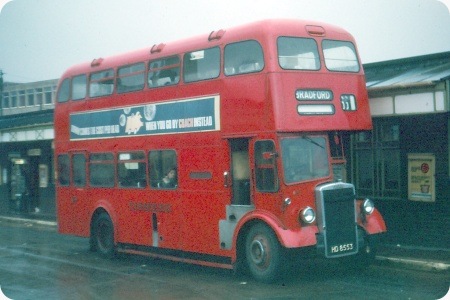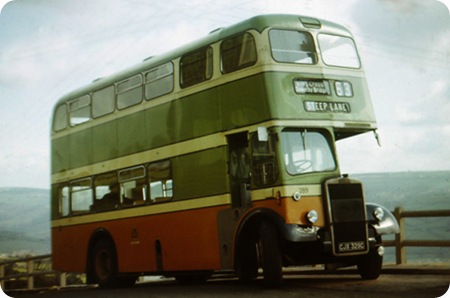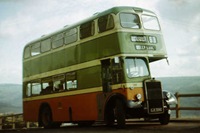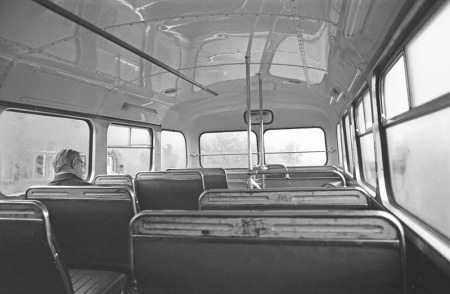Blackpool Corporation – Leyland Titan PD2/27 – PFR 334 – 334
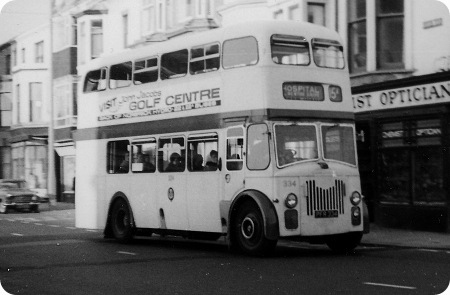
Photograph by ‘unknown’ if you took this photo please go to the copyright page.
Blackpool Corporation
1959
Leyland Titan PD2/27
Metro Cammell Weymann FH35/28R
Blackpool were really into the full frontal look I think it was to make them look like the trams that Blackpool is famous for. Before these normal looking full frontal Titans they had other versions which they classed as ‘streamlined’. The bodies were built by Burlingham a local body builder, I think they were bought out by the better know company called Duple.
There is a photo of a ‘streamlined’ Blackpool Leyland Titan here.
A full list of Titan codes can be seen here.
This photo is clearly of 334 (PFR 334), not 344. Good pic, though. 334 was one of a batch of 30 numbered 331-350. The 1960 abc British Bus Fleets No.6 (Lancashire), shows the seating as 61, reduced to 59 in the summer (for increased luggage space?). Burlingham were based in Blackpool and after the Duple takeover, the factory was known as Duple (Northern).
A Woods
Thanks for that, new glasses required I think, I have altered the heading so it is now correct.
Does your 1960 abc book have the above vehicle as a PD2/27 as my 1965 version because the website ‘Bus Lists on the Web’ has it has a PD2/40?
The 1965 abc British Bus Fleets No.6 lists a batch of 50 as the following:-
301 – 310 PD2/21
311 – 350 PD2/27
The ‘Bus Lists on the Web’ site as the same batch of 50 as the following:-
301 – 310 PD2/21
311 – 330 PD2/27
331 – 350 PD2/40
Can anyone solve this anomaly.
Peter
There is certainly plenty of odd information about these buses. I quote from two sources:
In "Blackpool’s Buses", by David Dougill, the fleet list shows 301-305 as PD2/21 with Burlingham bodies, while 306-310 had MCW bodies. 311-350 were PD2/27 with MCW bodies. "Trams and Buses Around Blackpool" by the well-know duo Steve Palmer and Brian Turner gives the same detail. The only difference between 311-330 and 331-350 is that the earlier numbers were delivered in 1958 and the later ones arrived in 1959.
Pete Davies
The PD2/40 was an exposed radiator variant of the breed I would suggest that Blackpool had no exposed radiator buses delivered post war. Early ones had full font bodies to a Blackpool design by Burlingham while later examples both fully fronted and half cab had variations on the Leyland Titan tin front Some of Blackpools PD3s had an asymmetrical full front due to the revised "St Helens front" of concealed radiator PD3s
Chris Hough
Chris, I’m no Blackpool expert but do I recall in the murky recesses of the mind that sometimes "exposed" radiators with smaller blocks were provided for certain full-front applications? Does that clarify – or muddy – the waters?
David Oldfield
This bus survived longer than most of its classmates as, along with 337, it was converted for use a Permanent Way staff bus in which guise they were numbered 434/7 (346 also worked for the Electrical Services department).
From my time at Blackpool I have a 1978 fleet list which shows these as PD2/27s which entered service on 25th and 26th March 1959 respectively.
David Beilby
Blackpool 334 was a PD2/27 as David Beilby confirms. To answer David Oldfield, Leyland supplied the ‘exposed radiator’ version of the Titan for full front designs where the front grille was part of the body design rather than being one of Leyland’s standard fronts. Examples are Ribble’s PD3’s with Burlingham and MCW bodies and the Southdown ‘Queen Mary’ Northern Counties bodied PD3’s. They were PD3/4 and PD3/5’s. As Blackpool used both the standard Leyland BMMO and St Helens style bonnets in their full fronts these Titans were the concealed front chassis types, PD2/21,PD2/27,PD3/1 and finally PD3A/1. The latter had the asymmetrical front windows with the nearside windscreen ‘drooping’ down to follow the shape of the St Helens style bonnet. This arrangement was also used on PD3A/2’s operated by Bolton Corporation with both East Lancs and MCW forward entrance bodies.
Philip Halstead
02/02/11 – 10:00
I was the last driver of PFR 339, one of the buses mentioned in the above article. It was being used as a play bus for the Wisbech area and survived in a working state until 1982. It used to move from one school to another in this area to provide a base for play schools in village where none existed.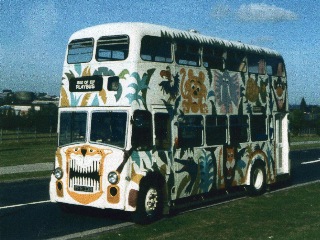 Gradually these village were able to form their own playgroups in accommodation of their own so PFR 339 worked at achieving it’s own demise. Eventually in 1982 it stayed in one school for a few years as a permanent base, but was eventually replaced by a more suitable form of accommodation. Clement Freud and his wife Jill were instrumental in setting it up in the first place.
Gradually these village were able to form their own playgroups in accommodation of their own so PFR 339 worked at achieving it’s own demise. Eventually in 1982 it stayed in one school for a few years as a permanent base, but was eventually replaced by a more suitable form of accommodation. Clement Freud and his wife Jill were instrumental in setting it up in the first place.
Peter Thatcher
04/11/18 – 07:21
When I were a nipper as the saying goes me, my sister took a day trip to Blackpool. We went by Ribble X61, a DP Leyland Leopard out and a White Lady Atlantean (RRN reg) back to Liverpool.
We had a ride on a Balloon tram (two 1s, two 6d). We kept the ticket for years,it was a TIM issue. From the tram ticket we got the date 8th August, 1968.
Note the date. I spotted a BRAND NEW gleaming Leyland Titan PD3A, which could only have been LFR 538/9/40G when a week old. Sadly they were Blackpool’s last such buses but they gave good service unlike many mid-late 1960s back loader of which only the Routemaster had a long life
In my opinion the St Helens bonnet didn’t suit a full front, which Blackpool Corporation recognised by specifying half cabs for 381-399 and 500-540. The 1950s Leyland Titans would have looked better with a Ribble style grille, but I guess BCT wanted to be different! .
Paul Mason
Quick links to the - Comments Page - Contact Page - Home Page
